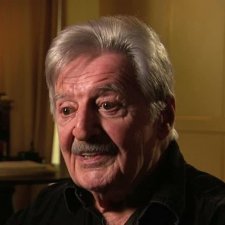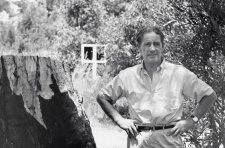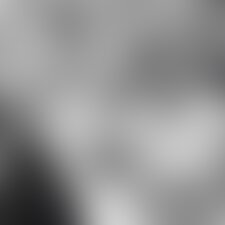Artist Eric Smith was born in Melbourne and worked as a graphic designer before serving in the Second World War. Afterwards, he studied painting at RMIT and began to exhibit regularly. In 1952 he moved to Sydney, where he emerged as a key exponent of abstraction. He was later a member of the group called the Sydney Nine, whose 1961 exhibitions asserted the rigour of abstract art in the context of debates about its integrity. Smith won the Archibald Prize for a third time with this portrait of his friend Peter Sculthorpe (1929–2014), the Tasmanian-born, internationally renowned composer. Inspired by Sculthorpe's music, Smith conceived of an expressive portrait to evoke the composer's creative process and started work on the painting less than three weeks before entries closed. A day before the deadline, he made drastic changes to the work, covering everything other than Sculthorpe's figure in thick orange paint. Squares of white were 'slashed' across the canvas, creating 'sheets of music exploding into the space'. Sculthorpe had the portrait on loan for a long time before the National Portrait Gallery purchased it from Smith in 2004. 'Most portraits by other artists tended to be rather dark and expressionistic,' Sculthorpe said in 2008, 'whereas Eric's painting brings in the sun … It captures my heart, my soul, my spirit, my music, everything.'
Purchased with funds provided by the Basil Bressler Bequest 2004
© Estate of Eric Smith
This is a portrait of Peter Sculthorpe the composer, painted by Eric Smith. It won the 1982 Archibald Prize. The portrait is in oil on canvas and measures about 1.5m tall by 2m wide in its frame. The frame consists of an inner white timber border and an outer border in pale peach.
The portrait is dominated by its vibrant orange-ochre coloured background in chalky, textured paint, with patches of saturated blue, red and yellow scattered across the canvas.
Peter is seated at a piano on the far left, side on, his face looking to the right of the scene. Sheets of music and bright squares of colour seem to emanate from his hands and the keyboard. Peter is painted realistically, however the brushwork is uneven, as if applied quickly and spontaneously, conveying energy and movement.
Peter is surrounded by an irregular halo of yellow paint. His thick hair, eyebrows and short moustache are dark, streaked with red, yellow and blue. His skin glows yellow and orange, highlighted with white. He wears a serious expression, dark eyes looking straight ahead at the loose pages of music, mouth closed.
His shirt is a bright cobalt blue, flecked with red and yellow, the collar undone and sleeves rolled up. Peter’s left elbow is bent up, parallel with his shoulder. His forearm is raised, his fingers touching the explosion of sheet music in front of him.
The pages are large white rectangles in different sizes, with bars and notes scratched roughly into their surfaces. Other rectangular forms in red, blue and yellow overlay and mix with them in a haphazard mass. Further rectangles splay across the right of the portrait culminating with a large red square in the top right corner of the work.
Peter’s right arm is lowered, bent at the elbow, fingers stretched over the keyboard. Dashes of paint radiate from his fingertips where they connect with the piano keys.
Seated on a piano stool, Peter’s right upper leg, in pale cream-yellow trousers, disappears beneath the keyboard. This area of the portrait, along the lower edge, is suggested with minimal outlines.
In the lower right portion of the portrait, in small red letters, the artist has signed: Eric Smith ‘82.
Written and voiced by Lucie Shawcross
Basil P. Bressler (44 portraits supported)



On one level The Companion talks about the most famous and frontline Australians, but on another it tells us about ourselves.



Legendary Australian composer, Peter Sculthorpe, describes the development of his career.



The complex connections between four creative Australians; Patrick White, Sidney Nolan, Robert Helpmann and Peter Sculthorpe.